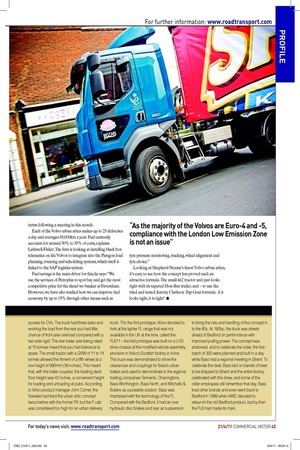URBAN ARTICS: A HISTORY PART 2
Page 34

Page 35

If you've noticed an error in this article please click here to report it so we can fix it.
Volvo was a pioneer of the urban artic concept and worked closely, initially, with Bass, to develop a small artic to replace the Bedford TL DLR8 small tractor unit that ceased production in 1987, leaving the UK’s largest brewer with 1,040 urban delivery trailers without a tractor to pull them. The theory behind the urban artic is simple – and to some degree based on the old British Rail city vehicle, the Scammell Mechanical Horse. Manoeuvrability with a long load platform up to 28ft as the load was handballed, and you cannot “top” containers of over 18 gallons – remember that some of the delivery points are 17th century coaching houses with poor access for CVs. The truck had three axles and working the load from the rear you had little chance of front axle overload compared with a two-axle rigid. The rear trailer axle being rated at 10 tonnes meant that you had tolerance to spare. The small tractor with a GVW of 11 to 14 tonnes allowed the fitment of a fifth wheel at a low height of 990mm (39 inches). This meant that, with the trailer coupled, the loading deck floor height was 42 inches, a convenient height for loading and unloading at pubs. According to Volvo product manager John Comer, the Swedes had tried the urban artic concept twice before with the former F6, but the F cab was considered too high for an urban delivery truck: “For the first prototype, Volvo decided to look at the lighter FL range that was not available in the UK at the time, called the FL611 – the first prototype was built on a LHD drive chassis at the modified vehicle assembly provision in Volvo’s Scottish factory in Irvine. This truck was demonstrated to show the clearances and couplings for Bass’s urban trailers and used to demonstrate to the regional trading companies Tennents, Charringtons, Bass Worthington, Bass North, and Mitchells & Butlers as a possible solution. Bass was impressed with the technology of the FL. Compared with the Bedford, it had air over hydraulic disc brakes and rear air suspension to bring the ride and handling of the concept in to the 80s. At 180hp, the truck was streets ahead of Bedford on performance with improved pulling power. The concept was endorsed, and to celebrate the order, the first batch of 300 were planned and built in a day while Bass had a regional meeting in Ghent. To celebrate the deal, Bass laid on barrels of beer to be shipped to Ghent and the entire factory celebrated with this brew, and some of the older employees still remember that day. Bass tried other brands and even went back to Bedford in 1989 when AWD decided to relaunch the old Bedford product, but by then the FL6 had made its mark.













































